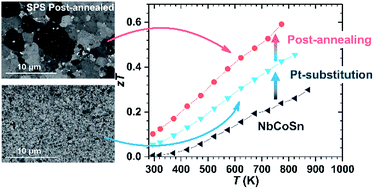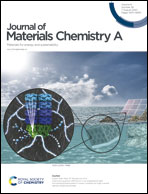Thermoelectric properties of n-type half-Heusler NbCoSn with heavy-element Pt substitution†
Abstract
Half-Heusler compounds with a valence electron count of 18, including ZrNiSn, ZrCoSb, and NbFeSb, are good thermoelectric materials owing to favorable electronic structures. Previous computational studies had predicted a high electrical power factor in another half-Heusler compound NbCoSn, but it has not been extensively investigated experimentally. Herein, the synthesis, structural characterization, and thermoelectric properties of the heavy-element Pt-substituted NbCoSn compounds are reported. Pt is found to be an effective substitute enabling the optimization of electrical power factor and simultaneously leading to a strong point defect scattering of phonons and the suppression of lattice thermal conductivity. Post-annealing significantly improves the carrier mobility, which is ascribed to the decreased grain boundary scattering of electrons. As a result, a maximum power factor of ∼3.4 mW m−1 K−2 is obtained at 600 K. In conjunction with the reduced lattice thermal conductivity, a maximum figure of merit zT of ∼0.6 is achieved at 773 K for the post-annealed NbCo0.95Pt0.05Sn, an increase of 100% compared to that of NbCoSn. This work highlights the important roles that the dopant element and microstructure play in the thermoelectric properties of half-Heusler compounds.



 Please wait while we load your content...
Please wait while we load your content...